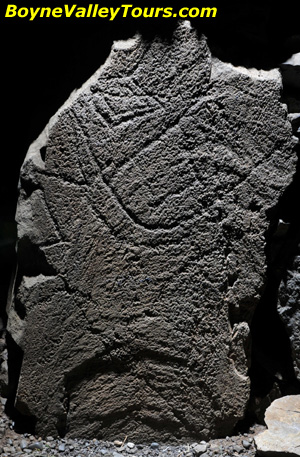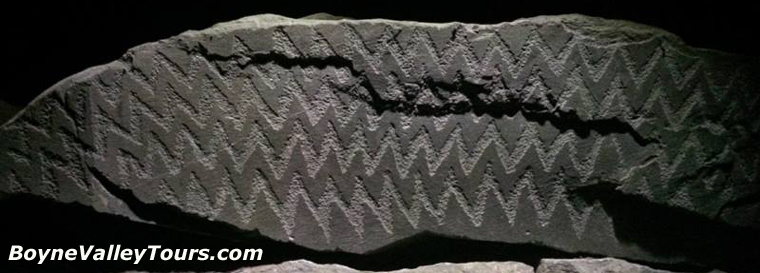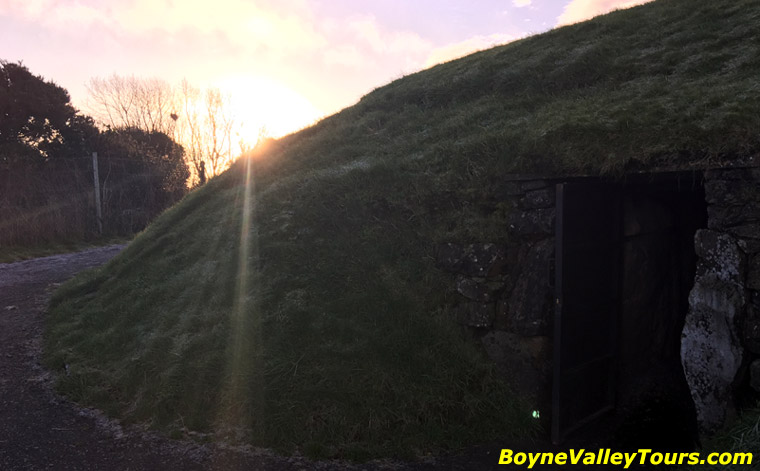Fourknocks Megalithic Passage Tomb
 Fourknocks
is a passage tomb on a smaller scale to Newgrange, however it is a much more intimate site.
There is no visitors centre and seldom anyone else around to disturb the peaceful atmosphere.
Spend as long as you want inside the chamber, studying the wonderful megalithic art or in quiet meditation.
The engraving of a human face and torso on a stone in the chamber is one of the oldest anthropomorphic representations in Ireland.
Fourknocks
is a passage tomb on a smaller scale to Newgrange, however it is a much more intimate site.
There is no visitors centre and seldom anyone else around to disturb the peaceful atmosphere.
Spend as long as you want inside the chamber, studying the wonderful megalithic art or in quiet meditation.
The engraving of a human face and torso on a stone in the chamber is one of the oldest anthropomorphic representations in Ireland.
Fourknocks was constructed about 5000 years ago and is contemporary to Newgrange and the other passage tombs in the Boyne Valley. It is located 16km (10 miles) southeast of Newgrange. The name Fourknocks is from the Irish Fuair Cnocs meaning Cold Hills.
Fourknocks has a short passage leading into a wide pear shaped chamber with three smaller offset chambers. The original roof was probably a wooden structure supported by a central pole. The current concrete roof was constructed in 1952 at the end of a 2 year excavation. Fragments of 65 burials were found in the tomb, both cremated and unburnt remains of adults and children. Decorated Pottery and Vessels and personal ornaments including pendants and beads were also found. All of the items found were moved to the National Museum.
The entrance to Fourknocks is too far north to have a solar alignment, however the Fourknocks mound is aligned with the path of Winter Solstice sunrise towards Newgrange. During the stone age the passage at Fourknocks was aligned with the helical rising of the “W” shaped constellation of Cassiopeia, perhaps this accounts for the dominance of W shaped zig zag megalithic art at Fourknocks.
Meath Megalithic Sites - Private Hire Day Tour
Step into a realm of ancient wonders and mystical landscapes with our exclusive private day tour to Fourknocks and the Megalithic Passage Tombs of the Boyne Valley. Immerse yourself in the rich history and unparalleled beauty of these iconic sites as you embark on a journey through time. This personalized experience promises a day filled with awe-inspiring sights, intriguing stories, and memories to last a lifetime.Fourknocks stands as a hidden gem, quietly nestled in the heart of the Boyne Valley. While it shares the landscape with its more renowned counterparts, Newgrange and Knowth, its distinct charm and historical significance are often overshadowed by the grandeur of the more celebrated sites. Yet, within the unassuming allure of Fourknocks lies a treasure trove of archaeological wonders, patiently awaiting discovery by those who seek to unravel the mysteries of the past.
The Boyne Valley is home to some of the world's most significant Megalithic Passage Tombs, and our private tour ensures an intimate encounter with these marvels. Visit the majestic Newgrange, a UNESCO World Heritage site older than Stonehenge and the Egyptian pyramids. Marvel at the architectural ingenuity of Knowth, with its impressive array of megalithic art and intriguing satellite tombs. Feel the spiritual energy that permeates Dowth, connecting you to a sacred past.
Our private day tour is curated to cater to your interests and preferences. Whether you're a history enthusiast, a nature lover, or simply seeking a unique adventure, our experienced guides will tailor the itinerary to ensure an unforgettable experience. Bask in the personalized attention as you delve into the mysteries of Dowth and the Boyne Valley's ancient wonders.
Our knowledgeable guides are passionate about the history and folklore of the Boyne Valley. With in-depth expertise, they bring the past to life, weaving captivating narratives that transport you back in time. Learn about the rituals, beliefs, and traditions of the ancient people who left their mark on these extraordinary sites. Access to Newgrange and Knowth is exclusively facilitated by the official onsite guides. To explore these sites, you have to participate in a group tour.
Relax and enjoy the scenic beauty of the Boyne Valley as you travel in comfort and style. Our private day tour includes luxurious transportation, allowing you to focus on the experience without the hassle of logistics.
Fourknocks - A Powerful Place
This 5,000 year-old passage-tomb cemetery and prehistoric complex are situated on a hill above the village of Naul, southeast of Newgrange. "Fourknocks I" is under the guardianship of the State and can be entered, while the other monuments are privately owned. The individual tombs in the complex seem to be interrelated, as described by Gabriel Clooney, who explains the gradual "twinning" of Fourknocks I and II over millennia. During this time, they transformed into complementary ritual settings. For instance, the passageway in Fourknocks I ascends, whereas the one in Fourknocks II, located 50 meters to the east, descends.The passageway of Fourknocks I opens to the northeast. The chambered cairn is easily accessible, you can obtain the key by following the instructions posted at the entrance to the path leading to Fourknocks. We highly recommend visiting the site with a guide, but if you choose to explore on your own, ensure you bring a flashlight.
The site was excavated in the early 1950s and reconstructed with a concrete domed ceiling, a practice seldom employed today. The exterior was re-grassed to replicate its appearance before excavation. You can climb to the top of the cairn and enjoy the view. The mound is located 10 miles (16km) southeast of the Newgrange and 11 miles (18km) east of Tara.
The 17ft (5m) long passage leads into a large, circular chamber measuring 18ft (5.5m) by 21ft (6.4m). The chamber, with its three recesses, has a somewhat bloated cruciform shape. Geometrical patterns adorn twelve stones, with zigzags being predominant. Observe the zigzags over the lintels; were they used to identify different tribes or families? Are they representations of star maps? One of the carved standing stones is said to depict a face.
Bone fragments from approximately 65 individuals were discovered in the passage and three side recesses, dating from both Neolithic times and later re-use during the Bronze Age. Cremains, unburned skulls, and long bones were carefully positioned, sometimes with associated small stones. Grave goods, including stone and bone pendants and beads, chalk marbles, pins (including a stunning antler pin), flints, and stone balls, were also found.
The roof was partially corbelled, likely closed off by a wooden roof with timber supports. Another theory suggests it was left open as a star observatory. Martin Brennan proposes that the zigzags on some stones represent Cassiopeia, the W-shaped constellation visible from Fourknocks during the Neolithic. It's challenging to reconcile a chamber open to the sky with the use of the mound as a grave. Clearly, there is much yet to be discovered.
If you enter Fourknocks, be very mindful of the energies you feel. Does it feel good, weird, welcoming, or unwelcoming? As with all sacred sites, it's crucial to ask for permission to enter, then be present, pay attention, and take care of yourself. Fourknocks remains a profoundly powerful place.
Book a Private Day Tour
Boyne Valley Tours Privacy, Terms and Conditions
Boyne Valley Tours Privacy, Terms and Conditions
Home
| Private Driver Tour
| Cruise Excursion
| Places
| Ireland's Ancient East
| About Us
| FAQs
| Contact
| Newgrange
| Knowth
| Hill of Tara
| Monasterboice
| Trim Castle
| Mellifont Abbey
| Slane



